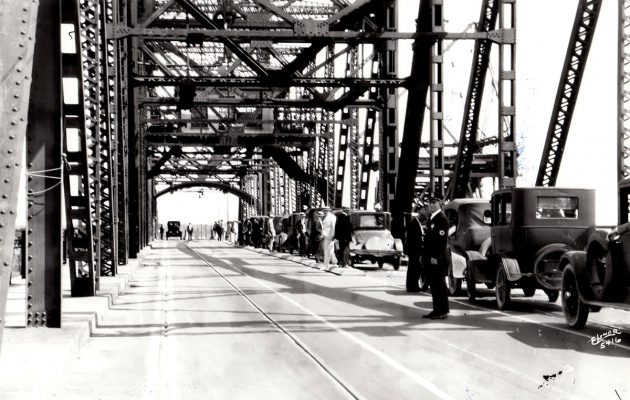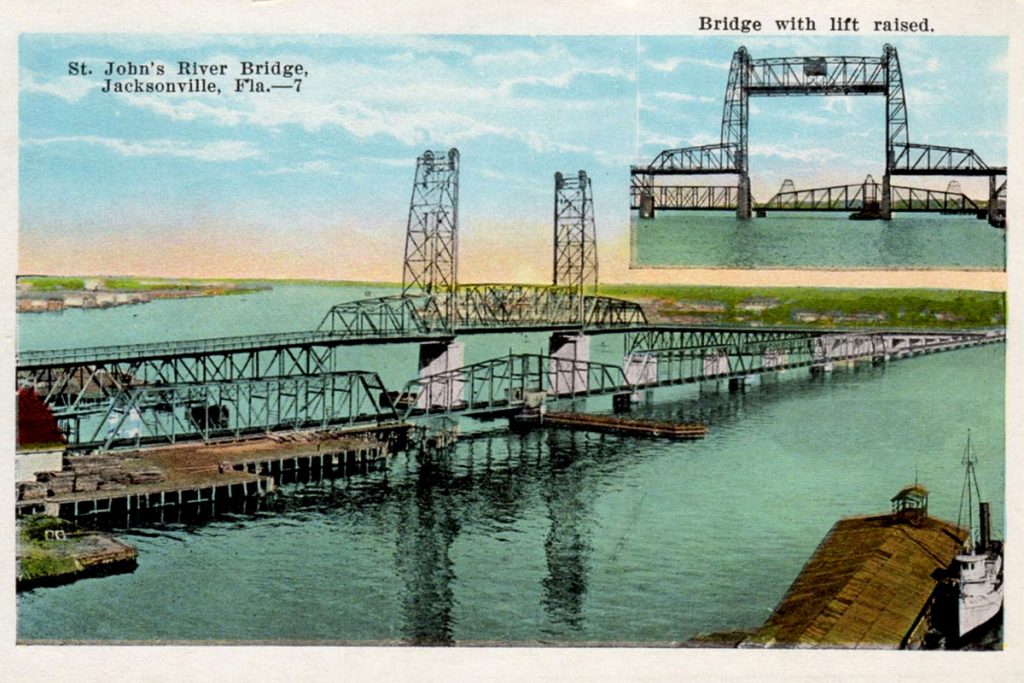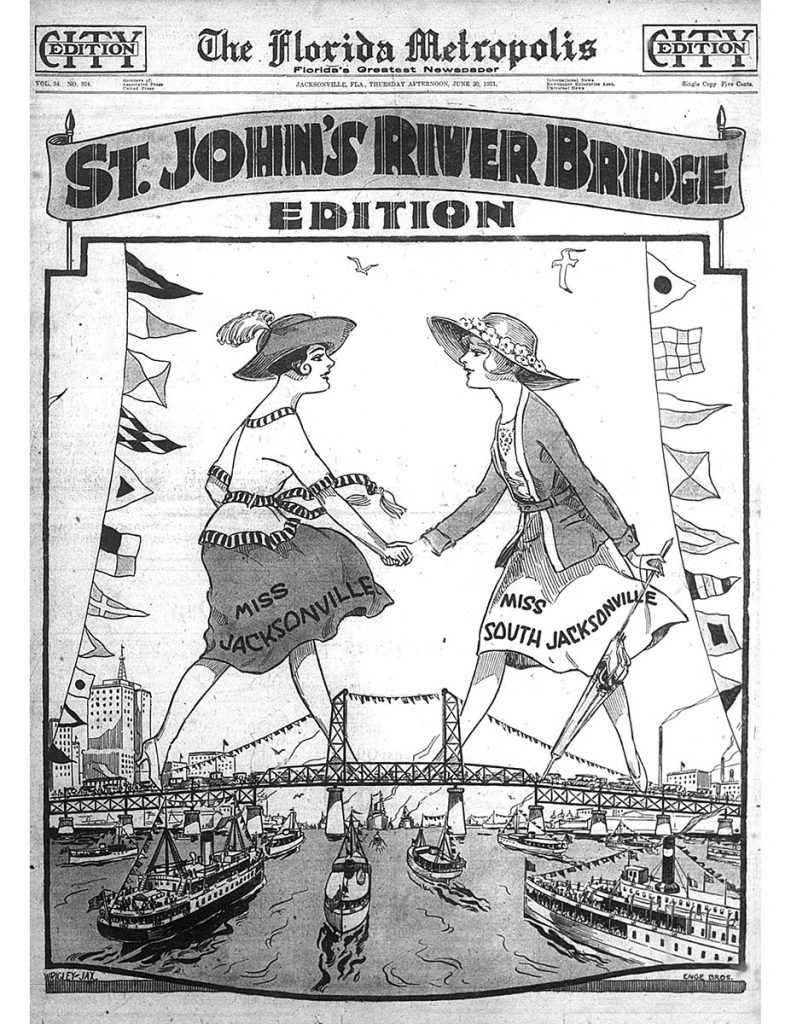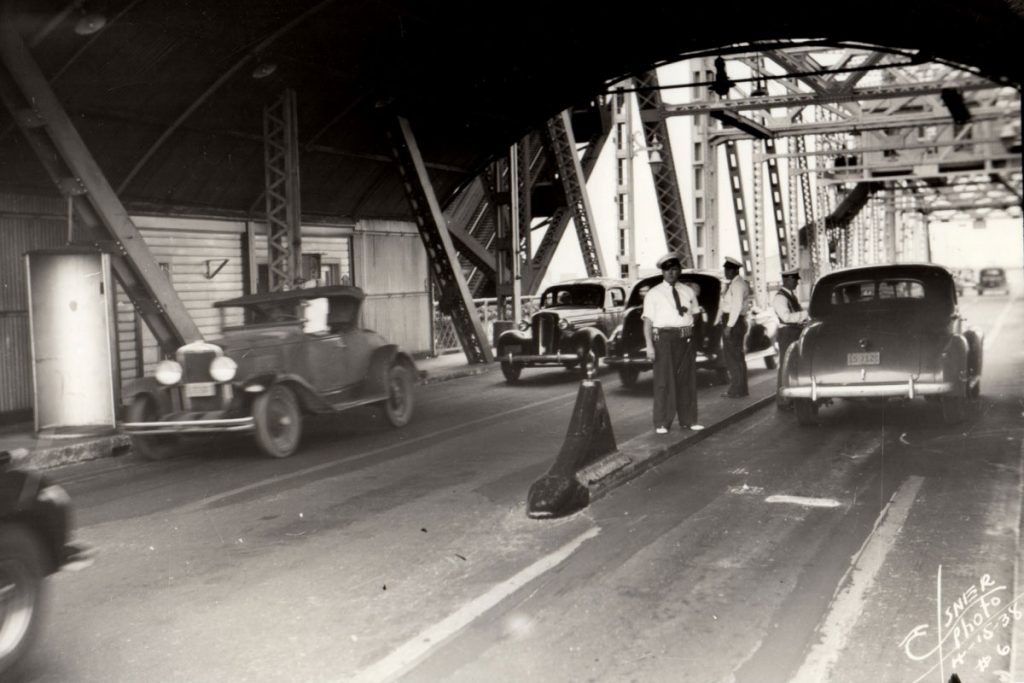Jacksonville’s million-dollar bridge celebrates 100 years of service
Posted on June 1, 2021 By Editor Riverside, Avondale, Ortega, Murray Hill, San Jose, San Marco, St. Nicholas, Top Stories

On July 1, 1921, 5,000 automobiles drove across the first bridge built to cross over the St. Johns River to connect the north bank of the river to the south bank. That may have been nearly every car in Jacksonville, as reported in Jacksonville’s Architectural Heritage by noted local historian Wayne Wood, because only about 5,000 families among the city’s nearly 100,000 population owned automobiles at the time. During the last week this month, the San Marco Preservation Society will mark the 100th anniversary of the opening of the Acosta Bridge with a multi-day celebration.
Nearly a century ago, the Jacksonville metro area that we know today was just beginning to be realized. On July 1, 1921, 5,000 automobiles drove across the first bridge built to cross over the St. Johns River to connect the north bank of the river to the south bank. That may have been nearly every car in Jacksonville, as reported in Jacksonville’s Architectural Heritage by noted local historian Wayne Wood, because only about 5,000 families among the city’s nearly 100,000 population owned automobiles at the time.

During the last week of this June, the San Marco Preservation Society will mark the 100th anniversary of the opening of the Acosta Bridge with a multi-day celebration. On June 24, 6 p.m., Wood will speak about the significance of the event.
On June 26, 11 a.m. a car parade will recreate the original crossing of the Acosta Bridge from the Southbank. Local dignitaries and descendants of the 1921 City officials, such as Andy Acosta Newman, St. Elmo Acosta’s granddaughter, will participate. The procession will return back to San Marco with more festivities in San Marco Square at noon.

The bridge was the result of a campaign begun by St. Elmo “Chic” Acosta in 1904. He was elected to the City Council in 1908 and 1912 and to the state legislature in 1913, with the proposed highway bridge one of his major issues. Despite a fair amount of opposition, in 1917 Jacksonville citizens approved a $950,000 bond issue to build the bridge. On Sept. 25, 1919, Acosta led the groundbreaking ceremonies to start construction.
The monumental span was originally opened with much fanfare and celebration. Dignitaries of the two cities of Jacksonville and South Jacksonville, which were separate communities at that time, joined a parade up each side of the bridge to meet in the middle for the official christening ceremony. Mayors from the two cities were joined by the Governor of Florida, local public servants, and other dignitaries.
“Miss South Jacksonville Elizabeth White, daughter of the first mayor of South Jacksonville, participated, not only in the first opening, but also years later when the original structure was replaced with a more modern bridge,” said Robin Robinson, historian, board member and past president of the San Marco Preservation Society.
According to Jacksonville’s Architectural Heritage, the bridge was proclaimed to be “Duval County’s Gift to Florida.” On Aug. 17, 1949, two years after Acosta’s death, the name of the span was changed to the “St. Elmo W. Acosta Bridge.”
In addition to being the first vertical lift bridge in Florida and the first automobile bridge over the St. Johns River, it was the first bridge in the Southeast to use a pneumatic process for the placement of its caissons. It originally had two streetcar tracks running down the middle.
The opening of the bridge sparked rapid growth in South Jacksonville and led to the community’s annexation by the City of Jacksonville in 1932. The bridge was also instrumental in the growth of the beaches area, with the creation of a more direct automobile route from the new bridge to the beach. In 1932 the Florida East Coast Railway ended the operations of its Jacksonville-to-Jacksonville Beach line. The tracks were taken up and the right-of-way was conveyed to the State of Florida in 1937, with Beach Boulevard completed along this route in 1949. Consolidation of the City of Jacksonville took effect in 1968, incorporating Neptune, Atlantic and Jacksonville Beaches into a combined governmental structure but retaining their municipal charters and local governments.

The bridge encouraged residential development in Mandarin as well, which had remained in decline until after World War I when it began its gradual growth as a residential community. The opening of the Acosta Bridge in 1921 shortened the travel time to Jacksonville making it easier to live in Mandarin and still stay connected to the city.
Also thanks to the bridge, the area just south of the river became highly attractive for residential development, one example being the Avondale neighborhood established by Telfair Stockton as a new standard for stylish neighborhoods in 1921.
Progress sometimes has unintended consequences, however. According to Robinson, within three weeks of opening the bridge in 1921, four men robbed the South Jacksonville Bank. A fifth man waited for the robbers in a getaway car. They all sped away after the robbery using the new bridge to make a clean escape.
The bridge’s impact was felt far beyond just Jacksonville as well. It opened up travel to points south along Florida’s east coast and contributed to the Florida Land Boom of the 1920s. It stood until it was replaced in 1991.




 (2 votes, average: 4.50 out of 5)
(2 votes, average: 4.50 out of 5)




